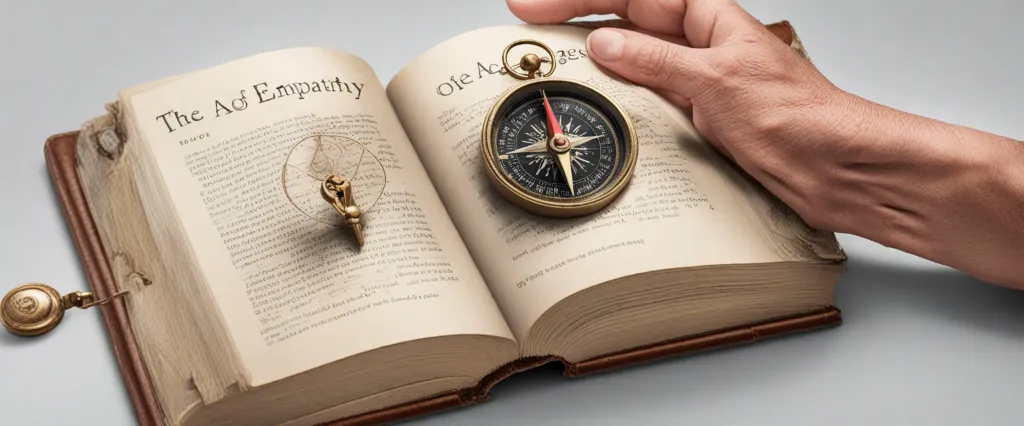
In the ever-evolving landscape of social sciences, the exploration of human behavior has captivated scholars and thinkers for centuries. Two notable works that have delved into the intricate complexities of human social interaction are “The Age of Empathy” by Frans de Waal and “The Social Animal” by David Brooks. These seminal texts offer unique perspectives on the fundamental question of what drives human behavior and the significant role that empathy and social connections play in shaping our lives.
Frans de Waal, a distinguished primatologist and ethologist, embarks on a fascinating journey in “The Age of Empathy” to uncover the roots of empathy not just within our species, but also in several animals. Through meticulous research and compelling anecdotes, de Waal challenges the conventional belief that empathetic behavior is exclusive to humans, arguing that it is deeply ingrained in our evolutionary history.
On the other hand, David Brooks, an esteemed journalist and social commentator, explores the intricacies of human social behavior in “The Social Animal.” Drawing from an array of subjects such as neuroscience, psychology, sociology, and even literature, Brooks weaves a captivating narrative that examines the various factors that shape our decision-making process, relationships, and overall well-being.
Though each work approaches the subject matter from a distinct perspective, they share a unifying theme: human behavior cannot be fully understood without acknowledging the role of empathy and social connections. Both de Waal and Brooks argue that empathy is an essential trait not only for our own personal and social development but also for the greater good of society at large.
Throughout this comparative study, we will explore the main arguments, key insights, and differing methodologies employed by de Waal and Brooks. By juxtaposing their perspectives, we will gain a deeper understanding of the multifaceted nature of human behavior, shedding light on how empathy and social connections shape our lives, both individually and collectively.
As we delve into the depths of these gripping works, we hope to unravel the intricate dynamics of human behavior, revealing the profound impact empathy and social interaction have on our species. Through this exploration, it becomes evident that the study of human behavior is not merely an intellectual pursuit but a means to cultivate a more compassionate and interconnected society.
Brief Summary of Two Books
The Age of Empathy by Frans de Waal
“The Age of Empathy” by Frans de Waal explores the nature of empathy in humans and animals. Drawing upon his years of research on primates and other animals, de Waal argues that empathy is not solely a human trait but is deeply rooted in our biology as social beings. He challenges the prevailing view that humans are inherently selfish and competitive, proposing instead that empathy and cooperation are basic instincts that have shaped our evolution.
De Waal presents numerous fascinating anecdotes and experiments that demonstrate empathetic behavior in different species, from apes and elephants to dogs and even rodents. He delves into the neuroscience behind empathy, discussing the role of mirror neurons and the importance of emotional contagion in fostering empathy. Moreover, he discusses how empathy contributes to our moral sense and social cohesion.
The book also explores the implications of empathy for various fields including parenting, education, and politics. De Waal argues that a lack of empathy is responsible for many societal issues, and he emphasizes the need to cultivate empathy in order to build a more compassionate and cohesive society. Additionally, he provides insights into how empathy can be further developed and nurtured in individuals and communities.
Overall, “The Age of Empathy” presents a thought-provoking and comprehensive exploration of the significance of empathy in both humans and animals, challenging existing notions about the nature of our species and offering a compelling case for empathy as a vital force in our lives.
The Social Animal by David Brooks
The Social Animal” is a book written by David Brooks that explores the complex depths of human behavior and social interaction through the story of two fictional characters named Harold and Erica. The book delves into various aspects of psychology, sociology, and neuroscience to explain how individuals form their identities, make decisions, and navigate relationships.
The narrative follows Harold and Erica from birth to old age, chronicling their personal and professional lives. Brooks tells their story while interweaving scientific insights into the workings of the human mind and society. Through Harold and Erica’s experiences, the book examines the powerful influence of unconscious biases, emotions, and social context on human behavior.
Brooks discusses how people construct narratives to make sense of their lives and create meaning. He explores the impact of childhood experiences, cultural norms, and societal expectations on personal development. The author also emphasizes the importance of close relationships, human connections, and social environments in shaping individuals’ well-being and achievements.
“The Social Animal” proposes that people are more than rational beings driven by self-interest, arguing that emotions and intuitions play a crucial role in decision-making. It emphasizes the importance of empathy, cooperation, and social intelligence in building healthy relationships and fostering a cohesive society.
Overall, Brooks’ book provides an interdisciplinary perspective on the complexities of human behavior and offers insights to help understand ourselves and others better.
Comparison between Two Books

Similarities in psychology
Both “The Age of Empathy” by Frans de Waal and “The Social Animal” by David Brooks explore various aspects of human psychology and delve into the nature of empathy and social behavior. Here are some similarities between the two books:
1. Importance of empathy: Both books emphasize the significance of empathy in human interactions. They argue that empathy is a natural trait that humans possess and is vital for the functioning of social relationships and communities.
2. Role of emotions: Both authors acknowledge the central role of emotions in human behavior. They highlight how emotions such as empathy, love, fear, and anger shape our thoughts, actions, and social interactions.
3. The social nature of humans: Both books discuss the inherently social nature of humans. They argue that we are fundamentally social creatures who rely on our relationships with others to form our identity, develop emotionally, and flourish in society.
4. Influence of relationships: Both authors recognize the impact of social relationships on individual growth and development. They explore how relationships with family, friends, and communities shape our values, beliefs, and overall well-being.
5. Evolutionary perspective: Both books incorporate an evolutionary perspective to understand human psychology. They explore the evolutionary origins of empathy and social behavior and emphasize how these behaviors have evolved to enhance our survival and reproductive success.
6. Connection between biology and psychology: Both authors highlight the connection between biology and psychology. They discuss the neural mechanisms underlying empathy, emotions, and social behavior, emphasizing how our biological makeup influences our psychological processes.
7. Importance of context: Both books emphasize the importance of considering the context in which human behavior occurs. They argue that understanding the context and circumstances is crucial for comprehending why people behave the way they do and for promoting empathy and social understanding.
Overall, “The Age of Empathy” and “The Social Animal” share many similarities in their exploration of human psychology, with a particular emphasis on the significance of empathy, emotions, social relationships, evolution, and the interplay between biology and psychology.
Divergences in psychology
The Age of Empathy by Frans de Waal and The Social Animal by David Brooks are both books that explore various aspects of human psychology and behavior, but they diverge in their approaches and perspectives.
One major difference between these books is their focus. Frans de Waal’s The Age of Empathy primarily examines empathy and prosocial behavior in animals and humans, and de Waal argues that empathy is deeply rooted in our evolutionary history. He gathers evidence from various scientific studies and observations of animals to support his claims. On the other hand, David Brooks’ The Social Animal is more concerned with the broader understanding of human behavior, weaving storytelling and fictional characters to illustrate key psychological concepts. Brooks aims to give readers practical insights into how psychology influences various aspects of human life, such as relationships, decision-making, and achievement.
In terms of methodology, de Waal’s The Age of Empathy is more heavily based on empirical research and scientific observations. He frequently cites studies conducted on animals and humans, drawing upon his vast experience as a primatologist. This lends a more scientific and academic tone to his book. Meanwhile, Brooks’ The Social Animal tends to rely more on anecdotal evidence and fictional narratives to illustrate his points. While he does reference some studies, the book is presented in a more accessible and engaging writing style, blending psychology with storytelling.
Another notable divergence is their underlying messages. de Waal’s The Age of Empathy argues for the importance of empathy and prosocial behavior in building a more compassionate society. He contends that empathy is a natural instinct and urges readers to cultivate it, embracing our evolutionary roots. In contrast, Brooks’ The Social Animal explores a broader range of psychological concepts, aiming to provide readers with insights into how human psychology can shape their lives and decision-making. He emphasizes the power of self-awareness and personal growth to navigate the complexities of society.
Overall, while both The Age of Empathy and The Social Animal delve into psychology, they differ in focus, methodology, and underlying messages. de Waal’s book centers on empathy in animals and humans, while Brooks’ work explores a wider array of psychological concepts. Additionally, de Waal’s book is more rooted in scientific research, whereas Brooks’ book incorporates narrative storytelling and personal anecdotes.

Conclusion
Both The Age of Empathy by Frans de Waal and The Social Animal by David Brooks are highly acclaimed books, each offering valuable insights on human behavior and social interactions. However, the choice ultimately depends on personal preference and the specific topics you find most intriguing. Here’s a brief overview of each book to help you make an informed decision:
1. The Age of Empathy by Frans de Waal:
Frans de Waal, a renowned primatologist and ethologist, delves into the world of empathy and its significance in human society, as well as in the animal kingdom. He explores the evolutionary origins of empathy, providing scientific evidence and captivating anecdotes to support his arguments. The book emphasizes the benefits of empathy for individuals, relationships, and societies.
If you are interested in understanding the origins and importance of empathy, animal behavior, and evolutionary psychology, The Age of Empathy could be a fascinating choice.
2. The Social Animal by David Brooks:
David Brooks, a journalist and writer, takes a more narrative approach to illuminate the complexities of human behavior and relationships. The book follows the lives of two fictional characters, Harold and Erica, showcasing the influences of their upbringing, personal experiences, and social interactions on their decision-making, relationships, and overall success.
The Social Animal delves into various areas such as neuroscience, sociology, psychology, and philosophy. It aims to provide a comprehensive view of human nature and the forces that shape us.
If you prefer a narrative-driven exploration of human behavior with insights from various fields, The Social Animal might be a great choice.
Ultimately, both books offer unique perspectives and valuable insights into human behavior and social interactions. Consider the aspects that resonate with your interests and explore a book that aligns with your preferences.



